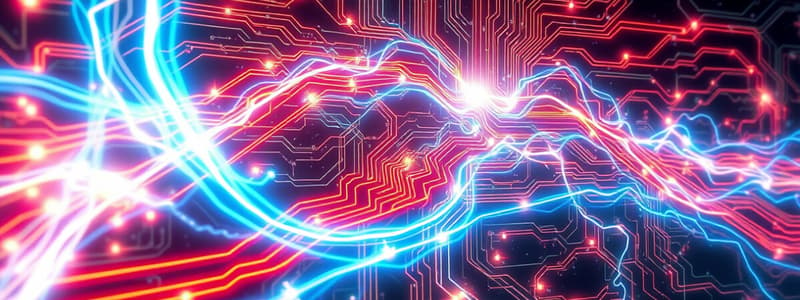Podcast
Questions and Answers
What controls the flow of current in a simple circuit?
What controls the flow of current in a simple circuit?
- The wires
- The voltage source
- A resistor
- The switch (correct)
Current flows from negative to positive in a circuit.
Current flows from negative to positive in a circuit.
False (B)
What is the unit of measurement for electric current?
What is the unit of measurement for electric current?
Ampere
The process called by which electricity generators convert energy from various sources into electrical power is known as __________.
The process called by which electricity generators convert energy from various sources into electrical power is known as __________.
Match the following components to their corresponding functions in an electricity grid:
Match the following components to their corresponding functions in an electricity grid:
What happens in a simple circuit when the switch is open?
What happens in a simple circuit when the switch is open?
Flashcards are hidden until you start studying
Study Notes
Electric Current Flow
- Electric current requires a closed circuit to flow, meaning all components must be connected without gaps.
- A voltage source, like a battery, serves as the driving force that pushes current through the circuit.
Control of Current
- Current flow in a simple circuit is controlled by a switch, which can open (break the circuit) or close (complete the circuit).
Open Switch Effects
- When the switch is open in a simple circuit, no current flows, and devices connected to the circuit do not operate.
Energy Transfer
- As electric current travels through a circuit, energy is transferred, typically in the form of electrical energy, enabling devices to function.
Circuit Diagrams
- Circuit diagrams are used as visual representations of electrical circuits, outlining the arrangement and connections of components.
Battery Symbol
- In circuit diagrams, a battery is represented by a pair of parallel lines, with one line longer than the other.
Current Direction
- Current in a circuit flows from the positive terminal of the voltage source to the negative terminal.
Measurement of Electric Current
- The unit of measurement for electric current is the Ampere (A), often referred to as "amps."
Voltage Description
- Voltage in a circuit can be described as the potential difference between two points, determining how much energy is available to move charges.
Voltage Measurement Instrument
- Voltage is measured using a voltmeter, an instrument designed to quantify electric potential difference.
Electricity Generation Process
- The process by which electricity generators convert energy from various sources (like wind, solar, fossil fuels) into electrical power is known as energy conversion.
Renewable Energy Source
- A common renewable energy source used for electricity generation is solar energy, harnessed through solar panels.
Electricity Grid Function
- The main function of the electricity grid is to distribute electrical power from generators to consumers, ensuring reliable energy supply.
Voltage Lowering Component
- Transforming stations within the electricity grid lower high voltage for safe distribution to homes and businesses.
High-Voltage Distribution Stage
- High-voltage electricity is carried over long distances during the transmission stage of electricity distribution to minimize energy loss.
Studying That Suits You
Use AI to generate personalized quizzes and flashcards to suit your learning preferences.




